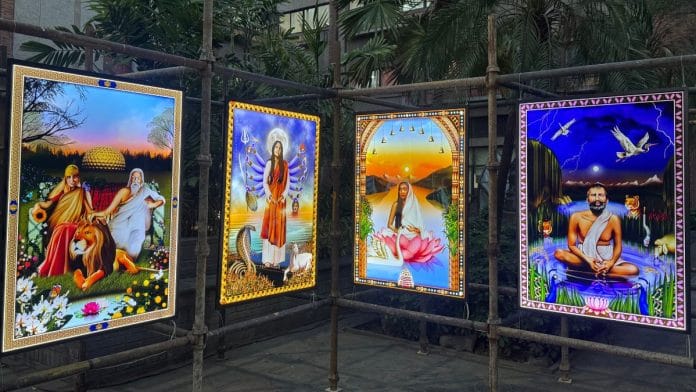New Delhi: Toward the end of the 18th century, colonial India witnessed a spiritual and social transformation. A new wave of saints emerged—those who blurred the religious boundaries and redefined their role in society. The Indian Saint Project exhibition at the India Habitat Centre captures this shift, blending art and academia to honour the saints, gurus, avatars, and social reformers of 19th- and 20th-century India.
“The Maha-gurus in the end of the 18th century were different. They didn’t have huge followers. The phenomena that we know now of a person with so many followers is modern,” said one of the creators of The Indian Saint Project, Michal Erlich, who is also an associate professor at the Jindal India Institute, OP Jindal Global University.
At the visual art gallery of IHC, nine digital hand paintings of Indian saints are displayed in an open corridor setting. As evening fell, the lightboxes illuminated the iconographies, drawing viewers to pause and look at the radiant portrait. Each artwork portrays a saint surrounded by symbolic elements from their lives—animals, natural landscapes, and divine motifs.
The Indian Saint Project drew inspiration from India’s rich Bazaar art movement. The movement, which underscored the rise and growth of the Indian art market, aligned with the rise of Maha-gurus phenomena. The exhibition depicts figures like Ramana Maharshi, Swaminarayan, Mirra Alfassa (The Mother), Sai Baba, Sri Aurobindo, Anandamayi Ma, MK Gandhi, and BR Ambedkar.
The event, which started on 16 March, will continue until 13 April. The artworks have been curated by a team of artists and academicians, including Israeli artistic duo Noy Haimovitz and Tamir Erlich, Michal Erlich, and Khinvraj Jangid, associate professor and director at Jindal Centre for Israel Studies.
“The crafted iconographies aim to create an immersive experience, inviting viewers to ‘hear’ the saints’ vani (voice) through visual form,” said the description board at the entrance of the visual art gallery elucidating the essence of the project.
India’s first woman saint
With ten vibrant blue arms protruding from her body, a smiling Anandamayi Ma stands in a field looking at the sky, a radiant moon glowing behind her head. A snake on her right side, and a goat resting on her left. Each of her hands holds a symbol—a trishul (trident), flute, sword, chakra, shankh (conch shell), and dhanush (bow). This is how the artists have portrayed the first female “mahaguru” of India.
Considered as the incarnation of Mahakali, Erlich said Anandamayi Ma was the first one to lead the Maha Kumbh procession. “Mahatma Gandhi went to her. Jawaharlal Nehru went to her. Even Indira Gandhi went to her. She was that popular.”
The elements used in the portraits are lifted from the real lives of these saints. The flute depicts Anandamayi Ma’s reverence for Lord Krishna and the snake her husband.
“And she renamed her husband Bholenath, which is also Shiva’s name. And he’s her first devotee in a way. Shiva and her husband in the iconography are depicted with a snake,” said Erlich.
The goat in the portrait depicts her stance against animal sacrifice. According to the artists, Anandamayi Ma said that “sacrifice your ego and animal nature” but not an animal.
Also read: Tourism is helping protect India’s intangible heritage. It took 10 yrs to get here
Ambedkar and Gandhi
A captivating portrayal at the art exhibition is of Ambedkar and Gandhi standing side by side. Ambedkar is holding two significant books—the Constitution of India and Annihilation of Caste—as people behind him enter the waters to drink. While Mahatma Gandhi holds the Bhagavad Gita as he leads the Salt March.
The inclusion of the two icons of India’s freedom struggle in The Indian Saint Project was thought-provoking. Erlich said the word ‘saint’ was a deliberate attempt to step back from religiosity.
“We define a saint as anyone that created some kind of a path that leads people away from suffering to liberation. It can be a spiritual liberation. It can be a social liberation. And most of the time, it’s both,” she said.
Erlich went on to say that had Ambedkar been alive, he would not have liked being called a “saint” but so many people in India worship him as one. “Because he fought for their liberation.”
Ambedkar and Gandhi had many points of disagreements. Erlich said the alignment of the portraits allows viewers to think about the commonalities between the two.
“Their shared commitment to non-violence. And I believe that they were in such close arguments because they had so many similarities,” Erlich added.
(Edited by Aamaan Alam Khan)






